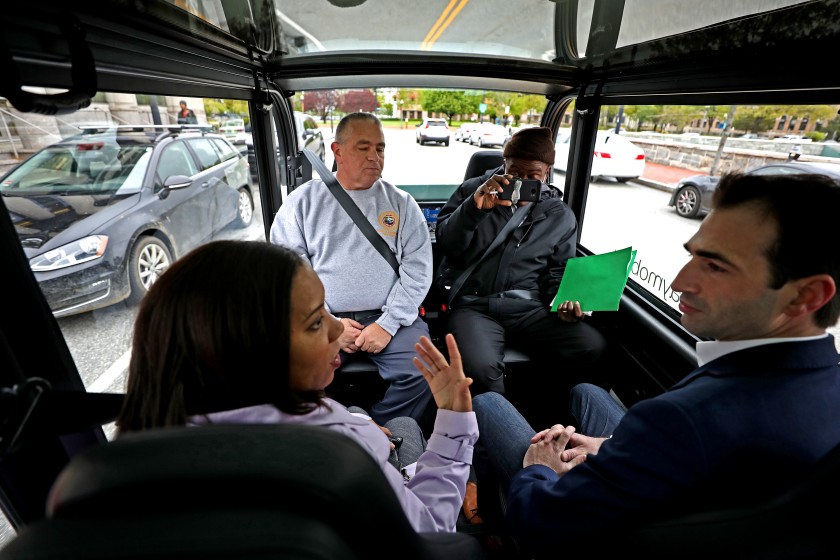Autonomous driving firm Pony.ai has raised around $500 million in its latest funding round, led by an investment by Japan’s largest automaker Toyota Motor Corp, two people with direct knowledge of the matter told Reuters. Toyota’s cheque of around $400 million marks its biggest investment in an autonomous driving company with a Chinese background, the… Continue reading Self-driving startup Pony.ai raises $500m in Toyota-led funding
Tag: Waymo/Google
Argo AI’s CEO explains why its fleet of self-driving taxis won’t be all-electric (at first)
One of the burning questions facing self-driving carmakers is whether it makes sense to go all-electric. Some companies, like GM-owned Cruise, are all in on battery-electric vehicles, seeing both self-driving and all-electric as the future. Others are keeping one foot in the present, like how Waymo is building a fleet that includes both all-electric Jaguar… Continue reading Argo AI’s CEO explains why its fleet of self-driving taxis won’t be all-electric (at first)
Cruise can now transport passengers in self-driving cars in CA
Cruise recently received a permit to transport passengers in its autonomous vehicles in California. Granted by the California Public Utilities Commission, the permit is part of the state’s Autonomous Vehicle Passenger Service pilot. As part of the program, Cruise must provide data and reports to the CPUC regarding any incidents, the number of passenger miles… Continue reading Cruise can now transport passengers in self-driving cars in CA
This self-driving car looks under the road for a safety boost in rain and snow
[embedded content] Over the past few years, autonomous vehicle technology and self-driving systems have reached new levels of sophistication and an experimental scanning system could lead to improved safety levels in poor weather. Self-driving capabilities are measured on a scale of levels 0 – 5; 0 being no automation and level 5 considered to be… Continue reading This self-driving car looks under the road for a safety boost in rain and snow
A self-driving start-up pulls in rare revenues by keeping its ambitions low – Los Angeles Times
May Mobility Inc.’s boxy white-and-green self-driving shuttle pulls up to a damp corner in downtown Detroit. Its big doors swing out, revealing a safety driver and six seats that face each other. It’s more comfortable than a subway car or most buses, but not by much. The shuttle slips down a bus lane and stops… Continue reading A self-driving start-up pulls in rare revenues by keeping its ambitions low – Los Angeles Times
Yandex races ahead with driverless car plans
MOSCOW (Reuters) – Internet company Yandex (YNDX.O), which reported lower growth in fourth-quarter profit on Friday, is poised to test its driverless cars outside Russia this year. FILE PHOTO: A view shows a self-driving car owned and tested by Yandex company during a presentation in Moscow, Russia August 16, 2019. REUTERS/Evgenia Novozhenina/File Photo Yandex has… Continue reading Yandex races ahead with driverless car plans
Ex-Waymo driver arrested for causing one of its vans to hit his car
Sponsored Links Waymo Waymo vehicles get involved in accidental collisions sometimes, but it looks like a January 30th crash in Tempe, Arizona was no accident at all. Authorities have arrested Raymond Tang, an ex-Waymo driver who the company described as “a disgruntled former” contractor, on suspicion that he deliberately caused an accident wherein one of… Continue reading Ex-Waymo driver arrested for causing one of its vans to hit his car
‘Disgruntled’ former Waymo self-driving car operator arrested for causing car crash
A former Waymo contractor was arrested after allegedly forcing one of the company’s self-driving cars to crash in Tempe last month, according to AZ Central. Police say 31-year-old Raymond Tang drove his Mazda recklessly around the Waymo vehicle, eventually swerving in front of the self-driving car and slamming his brakes, causing the Waymo vehicle to… Continue reading ‘Disgruntled’ former Waymo self-driving car operator arrested for causing car crash
Fiat Chrysler and AutoX confirm plans to work on robotaxis
Sponsored Links AutoX Fiat Chrysler Automobiles (FCA) is joining forces with the Chinese startup AutoX to bring self-driving robotaxis to China. The companies confirmed rumors of their partnership today and announced that the AutoX AI Driver platform will be installed in FCA Chrysler Pacificas. The robotaxis could appear in Chinese cities like Shenzhen and Shanghai… Continue reading Fiat Chrysler and AutoX confirm plans to work on robotaxis
Waymo’s self-driving car workers reportedly complain about finding leftover needles in the vehicles and a cut to their benefits (GOOGL)
Drivers of self-driving Waymo cars in the Phoenix suburbs have seen their benefits cut since shifting to working for the company as “vendors” instead of “contractors,” drivers told The Verge. They said vacation days went from 25 unpaid to five paid and five unpaid, according to the report. Drivers also complained about health benefits and… Continue reading Waymo’s self-driving car workers reportedly complain about finding leftover needles in the vehicles and a cut to their benefits (GOOGL)


